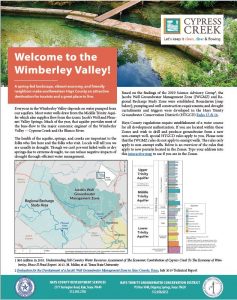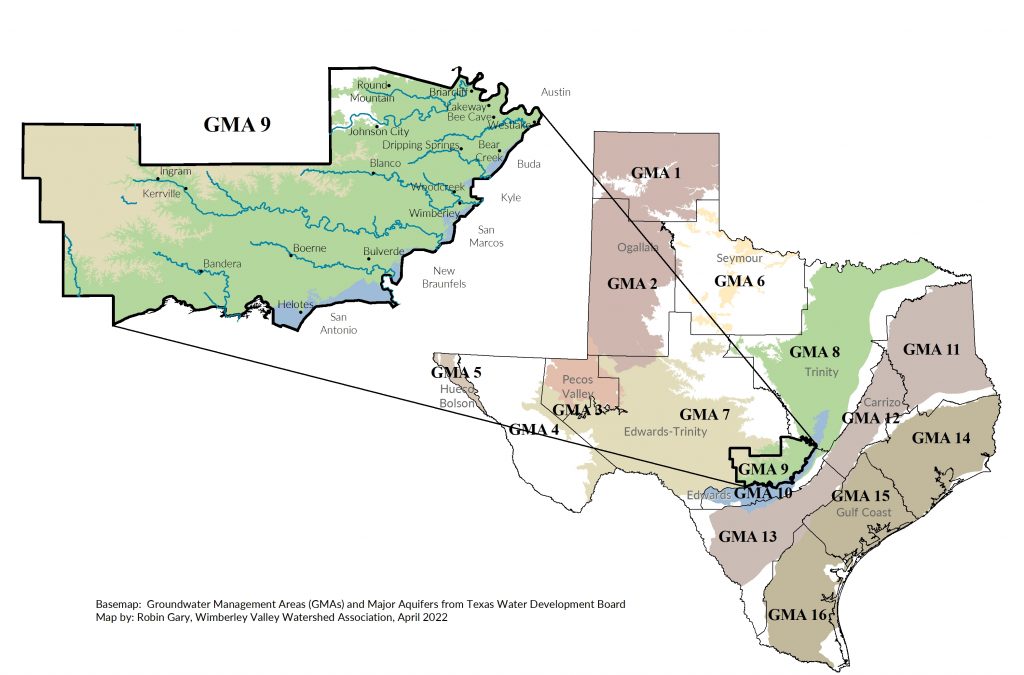In Texas, every 5 years the Texas Water Development Board, groundwater conservation districts, and stakeholders work through a planning process to establish a Desired Future Condition (DFC) for all the major aquifers in the state. DFCs for the major aquifers are defined by region for each of the 16 Groundwater Management Areas (GMAs).
GMA 9 covers much of the Hill Country and the DFC process will establish management goals for the Trinity Aquifers. The previous 5-year joint planning process’ details are found in the 2021 Explanatory Report and help establish future uses and conditions for the State Water Plan. The previous process set the following management conditions:

During the previous planning process, the Watershed Association joined many others in calling the 30′ average drawdown unreasonable for the Trinity Aquifer in GMA 9 (Watershed Association 2011 DFC Petition), because geology, aquifer dynamics, and location sensitive springs vary throughout the GMA and in the Upper, Middle and Lower Trinity Aquifer subsections. The Texas Water Development Board considered these comments in their Response to Comments. They stated, “In fact, there is no requirement that the DFC ensure the aquifer is managed sustainably. The DFC represents a policy decision by the Districts to balance competing goals of conserving the water in the aquifer and using that water to meet water demands” (pdf page 13).
 At a local level, the establishment of the Jacob’s Well Groundwater Management Zone provides much better management tools to protect groundwater availability and spring flow than DFCs can. The Groundwater Management Zone allows for limited additional pumpage and a tailored drought trigger based on spring flow. Still, this next round of DFC joint-planning is an important tool to protect groundwater availability, spring flow, and baseflow to our creeks and rivers across the Hill Country.
At a local level, the establishment of the Jacob’s Well Groundwater Management Zone provides much better management tools to protect groundwater availability and spring flow than DFCs can. The Groundwater Management Zone allows for limited additional pumpage and a tailored drought trigger based on spring flow. Still, this next round of DFC joint-planning is an important tool to protect groundwater availability, spring flow, and baseflow to our creeks and rivers across the Hill Country.
The Watershed Association will again participate and submit comments in the process to encourage groundwater protection. Here are a few key suggestions that would help improve the DFC and empower the groundwater conservation districts to better manage groundwater.
-
- Define independent DFCs for the Upper, Middle, and Lower Trinity (currently the Trinity is undifferentiated)
- Define quantifiable DFC targets that are easily monitored for compliance (30′ average drawdown across the entire GMA and within the Upper, Middle, and Lower Trinity is challenging if not impossible to monitor.)
- Use the Blanco River Aquifer Assessment model to better define DFCs that would be protective of Middle Trinity spring flows, and therefore, Hill Country creeks and rivers (Edwards Aquifer DFCs use spring flow as a metric)
- Develop DFCs that are protective of current users and encourage alternate supplies for future use (30′ drawdown would cause many existing wells to run dry)
The elected board members of our groundwater conservation districts represent the residents of GMA 9. The Desired Future Conditions and this stakeholder process is an opportunity to voice our desires for a sustainable future. Please consider attending the Groundwater: Planning for the Future event (Tues, Apr. 12, 2022 from 5:30-7pm at the Wimberley Community Center to learn more.
